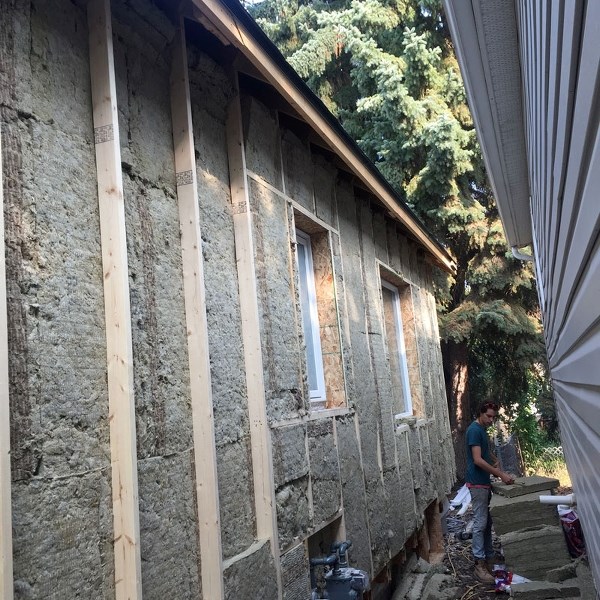Point an infrared camera at any home in St. Albert in winter and you’ll find that most look like they’re on fire.
That’s because most have terrible wall insulation. If you’ve got a 1970s or older home, the walls likely have an insulation value of about R8, notes net-zero home builder Peter Amerongen. That’s about as good as a modern window without the excuse of being see-through.
Lance White, a structural engineer with White and White Engineers in Edmonton, says his home’s century-old walls used to be so cold that pillows would freeze to them overnight.
He injected about $3,000 of insulation into them back in 2001 to boost them up to R20 levels (slightly above code). Not only is his home now super-toasty, it’s also super-quiet despite being half a block from traffic-heavy 124 Street.
Walls can account for about 20 per cent of a home’s heat loss, reports Natural Resources Canada. By bulking up their insulation, you can reduce that loss and save on energy.
Insulation is measured using R-values. A one-square-foot R1 wall would lose one BTU of heat per hour per degree Fahrenheit of temperature difference, which is pretty bad. An R100 one would lose just 1/100th a BTU, and would be exceptionally well insulated.
A brand-new home today will likely have about R15 insulation in its walls, Amerongen says. Most super-efficient homes aim for R40 – anything more than that, and it’s usually more cost-effective to invest in renewable power instead.
Former St. Albert resident Stuart Fix had a home in downtown Edmonton that had virtually no insulation in its 1940s walls apart from wood shavings and painted movie posters. As part of a massive retrofit of the whole house, he tore open and expanded the walls to stuff about 10 inches of insulation in them, getting them up to R42.
“It’s a lot of work,” he says, as he had to rip open the walls, hack off the concrete stucco with a saw and a crowbar, and seal off two chimneys.
It was also expensive. Fix estimates that he spent about $30,000 on the wall part of his retrofit, almost all of which was on labour.
Godo Stoyke of Carbon Busters estimates in an email that you’d need to spend about $37,950 to get a 1960s-era home up to R40-ish levels of wall insulation. Even with the province’s new carbon tax, it’d take you about 131 years to get your money back, as you’d save about $290.50 a year on gas.
If you had to replace the siding on your home anyway, the payback time drops to about 51 years, he continued. If you’re skilled enough to do this without outside labour, the cost drops to about $8,000, and you make that back in about 28 years.
“It’s a hell of a lot,” admits White, who pegs the cost of upgrading the walls of a 12,000 square-foot home at about $25,000, but if we’re serious about reducing greenhouse gas emissions, we have to get serious about home insulation.
“Changing your appliances doesn’t cut it.”
And wall upgrades can substantially shrink your carbon footprint. Stoyke says that the home he described would save about 43 GJ of natural gas a year and prevent some 2.21 tonnes of emissions – about 18 per cent of the average St. Albert resident’s emissions footprint.
Since insulation is cheap and opening walls isn’t, Amerongen recommends adding as much insulation as possible whenever you do a wall upgrade. You should also do your window upgrades at the same time, as you’ll have to take them out anyway.
As you can’t fit much insulation inside a wall, Amerongen and White recommend installing a new vapour barrier and insulation on the outside of the house instead. You lose a few inches of yard, but you gain a lot in heat, and you don’t mess up the inside of your house.
Fix says his main motivation for doing his house wasn’t money, but to create a nice home with a small environmental impact.
“There’s no drafts, there’s no cold spots,” he said, and it’s as quiet as the countryside. He’s able to keep the house nice and humid in the winter, and his gas bill is down to about $8 a month.
“The comfort aspect is more than worth the price of admission.”
Carbon Tracker
Step: Upgrade a 1960s home to R40 wall insulation.<br />Difficulty: Really hard.<br />Cost: About $38,000, or $8,000 if you do all the work yourself.<br />Payback Period: 28 to 131 years. <br />Carbon Saved: 2,205 kg/yr.
The Carbon Challenge
The Carbon Challenge will profile different ways you can shrink your carbon footprint and (usually) save money every second week. <br />Got a carbon question? Drop me a line at [email protected].




